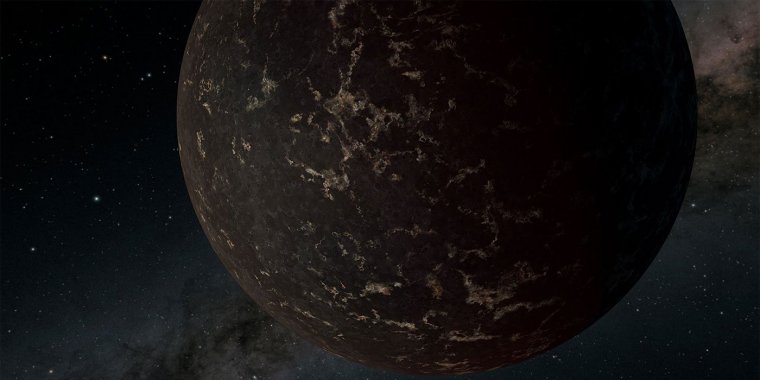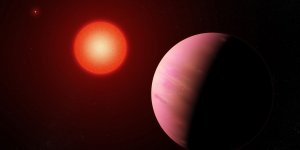| News / Space News |
A Rare Look at a Rocky Exoplanet's Surface
A new study using data from NASA's Spitzer Space Telescope provides a rare glimpse of conditions on the surface of a rocky planet orbiting a star beyond the Sun.

This artist's illustration depicts the exoplanet LHS 3844b, which is 1.3 times the mass of Earth and orbits an M dwarf star. The planet's surface may be covered mostly in dark lava rock, with no apparent atmosphere. Photo: NASA/JPL-Caltech/R. Hurt (IPAC)
The study shows that the planet's surface may resemble those of Earth's Moon or Mercury: The planet likely has little to no atmosphere and could be covered in the same cooled volcanic material found in the dark areas of the Moon's surface, called mare.
Discovered in 2018 by NASA's Transiting Exoplanet Satellite Survey (TESS) mission, planet LHS 3844b is located 48.6 light-years from Earth and has a radius 1.3 times that of Earth. It orbits a small, cool type of star called an M dwarf - especially noteworthy because, as the most common and long-lived type of star in the Milky Way galaxy, M dwarfs may host a high percentage of the total number of planets in the galaxy.
Spitzer was able to detect light from the surface of LHS 3844b. The planet makes one full revolution around its parent star in just 11 hours. With such a tight orbit, LHS 3844b is most likely "tidally locked," which is when one side of a planet permanently faces the star.
The star-facing side, or dayside, is about 1,410 degrees Fahrenheit (770 degrees Celsius). Being extremely hot, the planet radiates a lot of infrared light, and Spitzer is an infrared telescope. The planet's parent star is relatively cool (though still much hotter than the planet), making direct observation of LHS 3844b's dayside possible.
By measuring the temperature difference between the planet's hot and cold sides, the team found that there is a negligible amount of heat being transferred between the two. If an atmosphere were present, hot air on the dayside would naturally expand, generating winds that would transfer heat around the planet. On a rocky world with little to no atmosphere, like the Moon, there is no air present to transfer heat.
Understanding the factors that could preserve or destroy planetary atmospheres is part of how scientists plan to search for habitable environments beyond our solar system. Earth's atmosphere is the reason liquid water can exist on the surface, enabling life to thrive. On the other hand, the atmospheric pressure of Mars is now less than 1% of Earth's, and the oceans and rivers that once dotted the Red Planet's surface have disappeared.
Compared to Sun-like stars, M dwarfs emit high levels of ultraviolet light (though less light overall), which is harmful to life and can erode a planet's atmosphere. They're particularly violent in their youth, belching up a large number of flares, or bursts of radiation and particles that could strip away budding planetary atmospheres.
The Spitzer observations rule out an atmosphere with more than 10 times the pressure of Earth's. (Measured in units called bars, Earth's atmospheric pressure at sea level is about 1 bar.)
An atmosphere between 1 and 10 bars on LHS 3844b has been almost entirely ruled out as well, although the authors note there's a slim chance it could exist if the stellar and planetary properties were to meet some very specific and unlikely criteria. They also argue that with the planet so close to a star, a thin atmosphere would be stripped away by the star's intense radiation and outflow of material (often called stellar winds). (NASA)
YOU MAY ALSO LIKE





